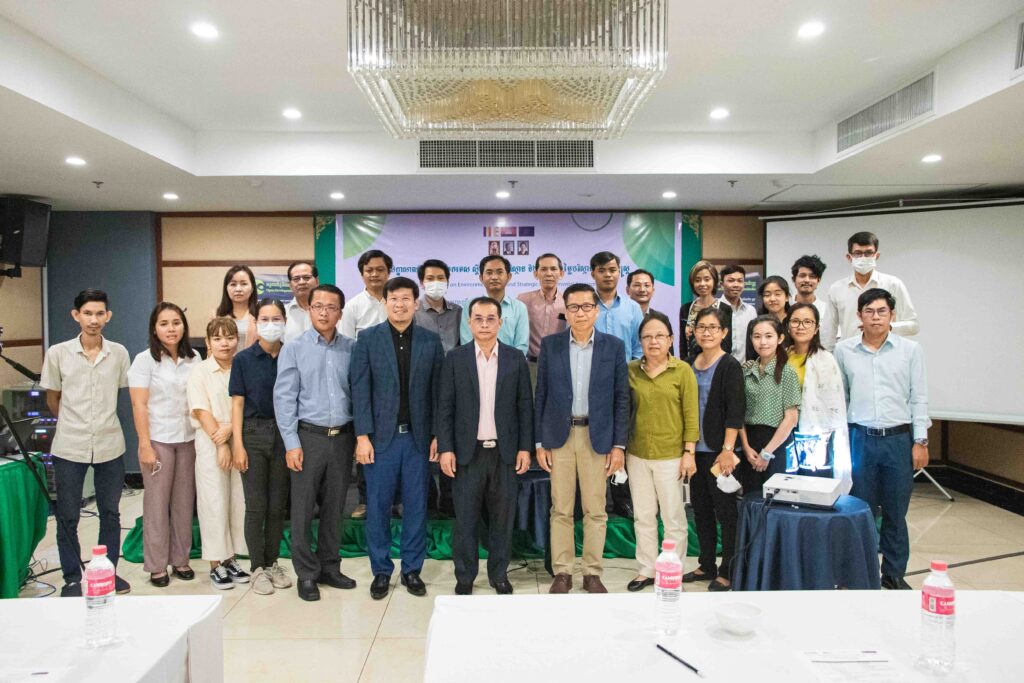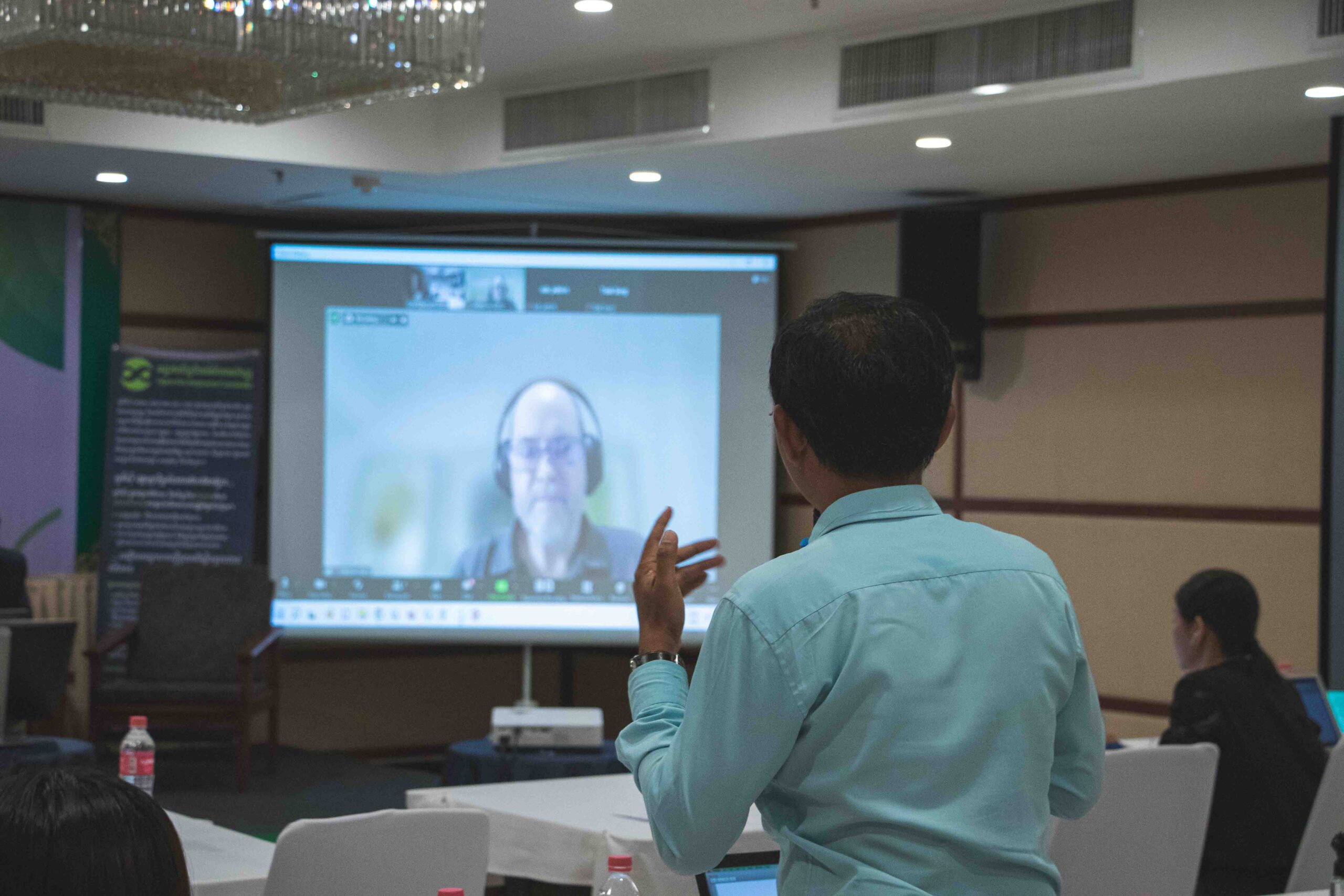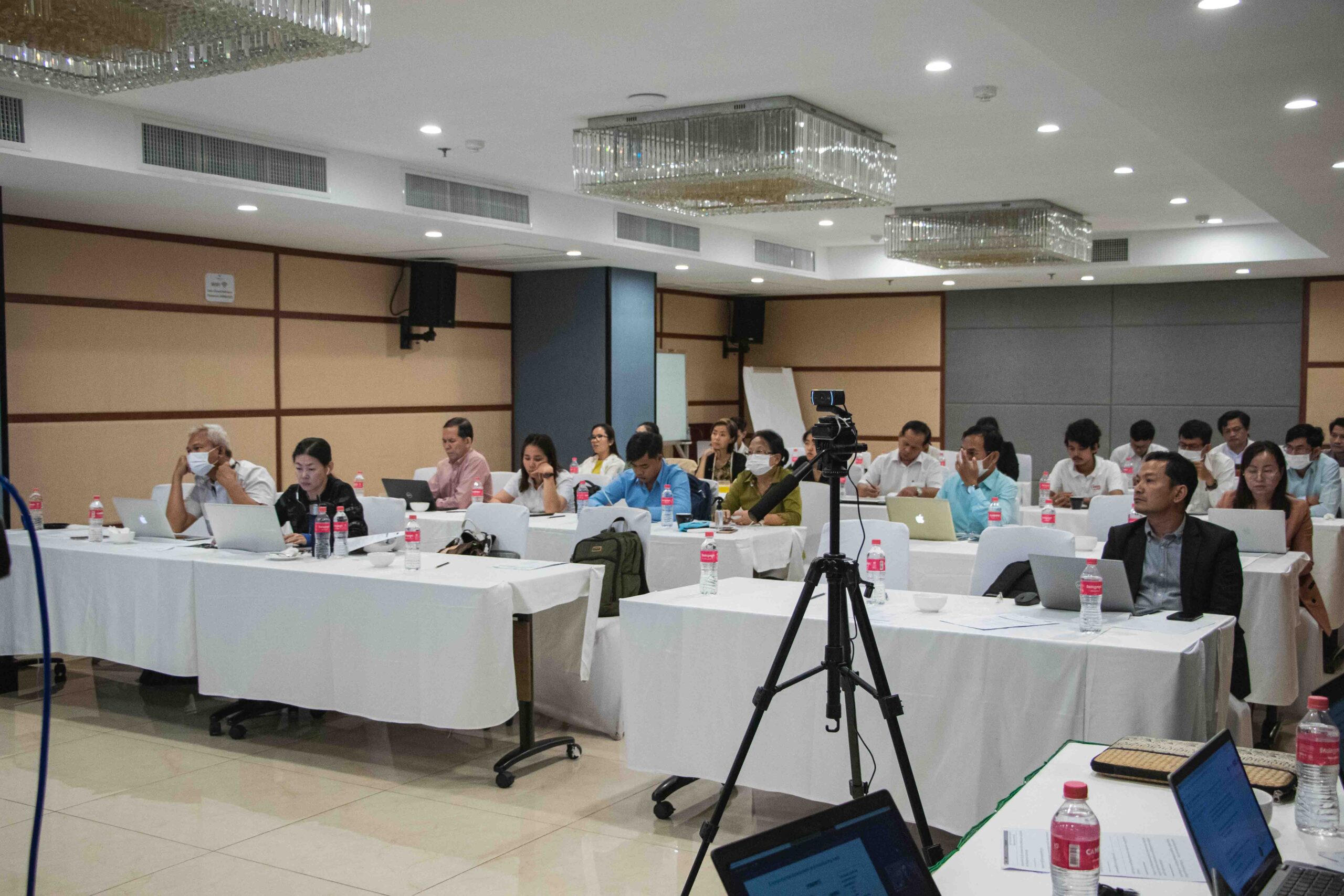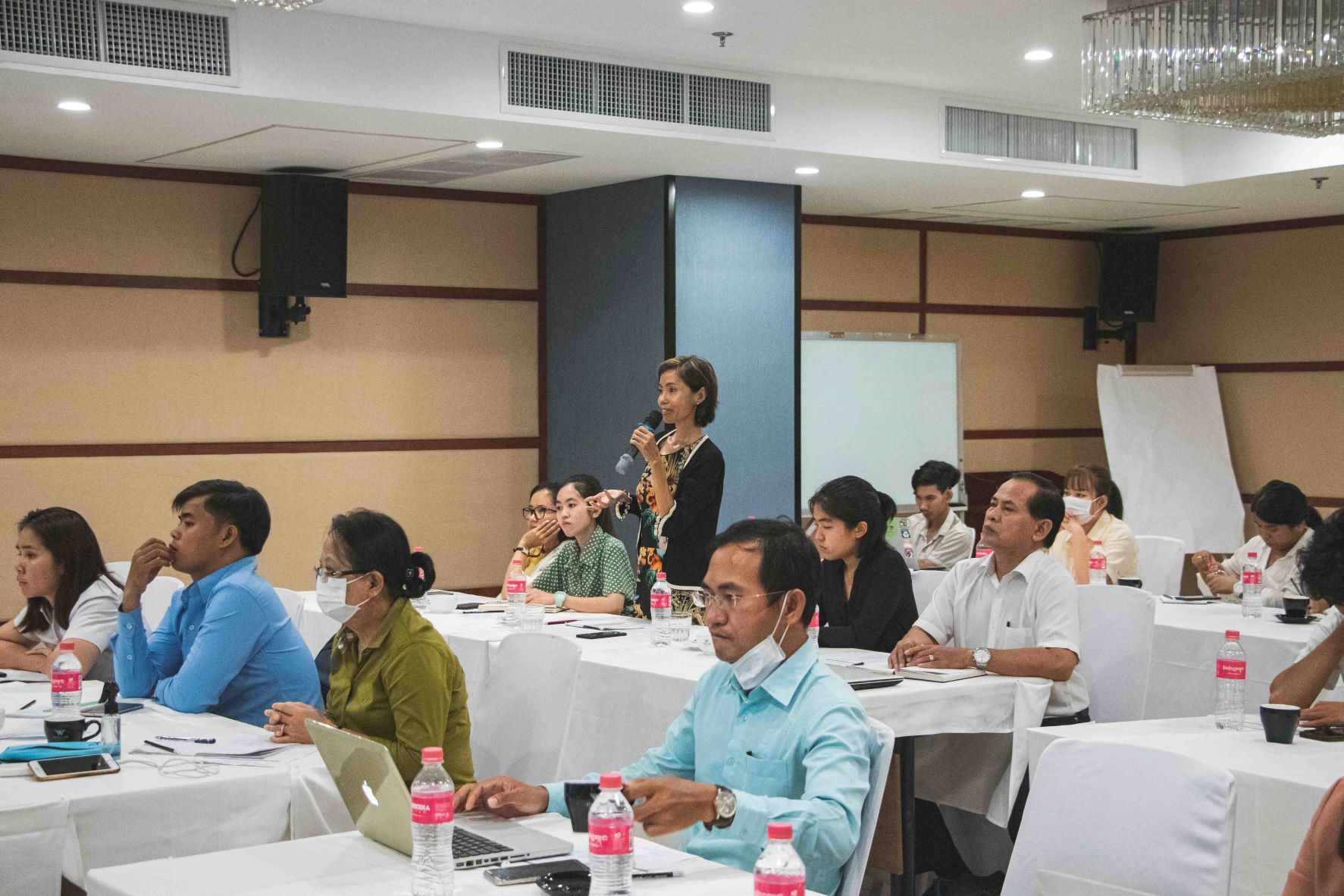ទិន្នន័យបរិស្ថាន និងការវាយតម្លៃបរិស្ថានជាយុទ្ធសាស្ត្រ
រាជធានីភ្នំពេញ ថ្ងៃទី០៣ ខែវិច្ឆិកា ឆ្នាំ២០២២ អង្គការទិន្នន័យអំពីការអភិវឌ្ឍបានរៀបចំសិក្ខាសាលាកម្រិតបច្ចេកទេសស្តីពីទិន្នន័យបរិស្ថាន និងការវាយតម្លៃបរិស្ថានជាយុទ្ធសាស្ត្រ។ សិក្ខាសាលានេះត្រូវបានគាំទ្រដោយទីភ្នាក់ងារសហរដ្ឋអាមេរិកសម្រាប់ការអភិវឌ្ឍន៍អន្តរជាតិ តាមរយៈអង្គការសុខភាពគ្រួសារអន្តរជាតិ ក្រោមមូលនិធិសម្រាប់ចង្កោមអង្គការសង្គមស៊ីវិលពីគម្រោងគាំទ្រអង្គការសង្គមស៊ីវិល និងមូលនិធិហេនរេចបូល ក្រោមគម្រោងលើកកម្ពស់ការវាយតម្លៃហេតុប៉ះពាល់បរិស្ថានសម្រាប់អភិបាលកិច្ចបរិស្ថានប្រកបដោយតម្លាភាព និងឆ្លើយតបកាន់តែច្រើននៅកម្ពុជា។ សិក្ខាសាលានេះមានគោលបំណង៖
- លើកកម្ពស់ការយល់ដឹងពីការវាយតម្លៃបរិស្ថានជាយុទ្ធសាស្ត្រ ក្នុងចំណោមអង្គការសង្គមស៊ីវិល ពលរដ្ឋសារព័ត៌មាន ជនជាតិដើមភាគតិច និងអ្នកស្រាវជ្រាវ
- ពិភាក្សា និងបង្ហាញពីបច្ចុប្បន្នភាពនៃការវាយតម្លៃបរិស្ថានជាយុទ្ធសាស្ត្រនៅប្រទេសកម្ពុជា
- កំណត់សក្តានុពលនៃការរួមបញ្ជូលការវាយតម្លៃបរិស្ថានជាយុទ្ធសាស្ត្រនៅក្នុងការគ្រប់គ្រងបរិស្ថាន និងធនធានធម្មជាតិ។
ព្រឹត្តិការណ៍នេះមានអ្នកចូលរួមចំនួន ៣២នាក់ (ស្រី ១១នាក់) មកពីក្រសួងផែនការ អង្គការមូលនិធិសកលសម្រាប់អភិរក្សធម្មជាតិ អង្គការសមាគមអភិរក្សសត្វព្រៃ អង្គការសុខភាពគ្រួសារអន្តរជាតិ អង្គការក្រៅរដ្ឋាភិបាលជាតិ និងអន្តរជាតិដទៃទៀត អង្គការសហគមន៍មូលដ្ឋាន អ្នកសារព័ត៌មាន អ្នកស្រាវជ្រាវ និងជនជាតិដើមភាគតិច។
ការវាយតម្លៃហេតុប៉ះពាល់បរិស្ថាន និងការវាយតម្លៃបរិស្ថានជាយុទ្ធសាស្ត្រ
លោក ធី ទ្រី នាយកប្រតិបត្តិនៃអង្គការទិន្នន័យអំពីការអភិវឌ្ឍ និងលោក MATHEW Baird នាយកវិទ្យាស្ថានស្រាវជ្រាវអាស៊ីសម្រាប់ច្បាប់បរិស្ថាន បានលើកឡើងពីភាពខុសគ្នារវាងការវាយតម្លៃហេតុប៉ះពាល់បរិស្ថាន និងការវាយតម្លៃបរិស្ថានជាយុទ្ធសាស្ត្រក៏ដូចជានីតិវិធីមួយចំនួន។ ជាទូទៅ គម្រោងអភិវឌ្ឍន៍ជំរុញឱ្យមានការអភិវឌ្ឍន៍សេដ្ឋកិច្ច ប៉ុន្តែយើងមិនគួរធ្វេសប្រហែស ឬព្រងើយកន្តើយចំពោះផលប៉ះពាល់ដល់បរិស្ថាន និងសង្គមឡើយ។ ការវាយតម្លៃបរិស្ថានជាយុទ្ធសាស្ត្ររួមបញ្ចូលការពិចារណាអំពីបរិស្ថានទៅក្នុងគោលនយោបាយ ផែនការ និងកម្មវិធី។ វាត្រូវបានប្រើប្រាស់ដើម្បីប៉ាន់ប្រមាណ និងវាយតម្លៃផលវិបាកនៃការអភិវឌ្ឍជាក់លាក់នៃនយោបាយ ផែនការ និងកម្មវិធី។ វាមានន័យថាគម្រោងអភិវឌ្ឍន៍មិនទាន់បានទទួលបានយល់ព្រមពីរាជរដ្ឋាភិបាលនៅឡើយទេ។ រដ្ឋាភិបាលនឹងសម្រេចថាតើគម្រោងនេះអាចអនុវត្ត ឬវិនិយោគនៅក្នុងតំបន់នោះបានដែរឬទេ។ ការវាយតម្លៃបរិស្ថានជាយុទ្ធសាស្ត្រ គឺធ្វើឡើងមុនពេលធ្វើការវាយតម្លៃហេតុប៉ះពាល់បរិស្ថាន។ ជាទូទៅការវាយតម្លៃបរិស្ថានជាយុទ្ធសាស្ត្រកើតឡើងមុនការសម្រេចចិត្តសំខាន់ៗទាំងអស់ដែលផ្តល់អត្ថប្រយោជន៍សំខាន់ៗ ដែលផ្ទុយទៅនឹងការវាយតម្លៃហេតុប៉ះពាល់បរិស្ថានដែលធ្វើឡើងបន្ទាប់ពីការសម្រេចចិត្ត។ ដើមឡើយ ការវាយតម្លៃបរិស្ថានជាយុទ្ធសាស្ត្រត្រូវបានធ្វើឡើងដើម្បីបំពេញចន្លោះខ្វះខាតរបស់ការវាយតម្លៃហេតុប៉ះពាល់បរិស្ថាន ដោយសារតែភាពនៅមានកម្រិតរបស់វាក្នុងការធ្វើសមាហរណកម្មគោលនយោបាយបរិស្ថាននៅកម្រិតយុទ្ធសាស្ត្រ ជាពិសេសនៅកំឡុងពេលធ្វើគោលនយោបាល និងផែនការ។ សមត្ថភាពនៃការវាយតម្លៃហេតុប៉ះពាល់បរិស្ថានក្នុងការគណនាឥទ្ធិពលរបស់គម្រោងនៅមានកម្រិតនៅឡើយ។ ការវាយតម្លៃបរិស្ថានជាយុទ្ធសាស្ត្រជាដំណើរការពហុដំណាក់កាលដែលផ្តោតលើនិរន្តរភាព ប្រើវិធីសាស្ត្រសកម្មមុនចំពោះសកម្មភាពអភិវឌ្ឍន៍ទាំងអស់ ដោយកំណត់អត្តសញ្ញាណឧបសគ្គសំខាន់ៗ មុនពេលការអនុម័តចុងក្រោយ។ ការចូលរួមជាសាធារណៈគឺជាចំណុចសំខាន់ ហើយវាត្រូវតែបញ្ចូលទៅក្នុងដំណើរការទាំងការវាយតម្លៃបរិស្ថានជាយុទ្ធសាស្ត្រ និងការវាយតម្លៃហេតុប៉ះពាល់បរិស្ថាន។ ពួកវាបំពេញគ្នាទៅវិញទៅមក និងចាំបាច់ត្រូវមានទាំងពីរ។
លោក ធី ទ្រី ក៏បានបង្ហាញវីដេអូអំពី UNECE SEA ដែលបានបង្កើតឡើងដោយគណៈកម្មការសេដ្ឋកិច្ចរបស់អង្គការសហប្រជាជាតិសម្រាប់អឺរ៉ុប ដែលជាផ្នែកមួយនៃកម្មវិធីដែលផ្តល់មូលនិធិដោយសហភាពអឺរ៉ុប “Greening the Economies in the European Neighborhood”។ ពិធីសារនេះបង្កើតនូវនីតិវិធីច្បាស់លាស់ និងតម្លាភាពសម្រាប់ការបញ្ចូលបញ្ហាបរិស្ថាន និងសុខភាពទៅក្នុងផែនការអភិវឌ្ឍន៍ជាតិ កម្មវិធី និងច្បាប់។
ផែនការរៀបចំដែនដី និងវិធីសាស្ត្ររួមបញ្ចូលតំបន់ទេសភាព
លោក សេង ទៀក នាយកប្រចាំប្រទេសនៃអង្គការមូលនិធិសកលសម្រាប់អភិរក្សធម្មជាតិ បានធ្វើបទបង្ហាញពីការអនុវត្តសំខាន់មួយដែលមានឈ្មោះថា “ផែនការរៀបចំដែនដីខេត្តមណ្ឌលគិរី”។ លោកបានគូសបញ្ជាក់ពីការវិភាគផ្អែកលើសេណារីយ៉ូឆ្នាំ២០៤០ សម្រាប់ខេត្ត ដោយបែងចែកជាបីសេណារីយ៉ូគឺ ការអភិរក្ស សេដ្ឋកិច្ចបៃតង និងអាជីវកម្មដូចធម្មតា។ សេណារីយ៉ូទីមួយ “ការអភិរក្ស” អាចរក្សាគម្របព្រៃឈើក្នុងខេត្តមណ្ឌលគិរីរហូតដល់ ៨៥ភាគរយ ដោយការពារជាចម្បងនូវព្រៃឈើទាំងអស់ក្នុង និងក្រៅតំបន់ការពារ និងការប្រើប្រាស់តំបន់មិនមែនព្រៃឈើសម្រាប់តំបន់កសិកម្ម និងអភិវឌ្ឍន៍។ សេណារីយ៉ូទីពីរ “សេដ្ឋកិច្ចបៃតង” ការពារតែព្រៃឈើនៅក្នុងតំបន់ការពារ ចំណែកព្រៃឈើនៅខាងក្រៅតំបន់ការពារ និងតំបន់មិនមែនព្រៃឈើត្រូវប្រើប្រាស់សម្រាប់តំបន់អភិវឌ្ឍន៍កសិកម្ម។ តាមរយៈការធ្វើដូច្នេះ គម្របព្រៃឈើអាចនៅសល់ ៥៣ភាគរយ នៅឆ្នាំ២០៤០។ សេណារីយ៉ូចុងក្រោយ “អាជីវកម្មដូចធម្មតា” នឹងមិនអនុវត្តការការពារព្រៃឈើទេ ហើយគម្របព្រៃឈើអាចនឹងនៅមានត្រឹមតែ ៣៤ភាគរយប៉ុណ្ណោះ។ សរុបមក សេណារីយ៉ូទីពីរគឺនឹងប្រើសម្រាប់ផែនការដែនដីសម្រាប់ខេត្តមណ្ឌលគិរី ហើយនឹងត្រូវអនុម័តក្នុងពេលឆាប់ៗនេះ។
ផែនការដែនដីគឺមានសារៈសំខាន់ណាស់ ព្រោះវាមានសក្តានុពលក្នុងការផ្តល់នូវគោលការណ៍អភិវឌ្ឍន៍ប្រកបដោយប្រសិទ្ធភាព និងឧបករណ៍សម្រាប់ធ្វើសេចក្តីសម្រេចចិត្តដែលមានព័ត៌មាន និងដំណើរការអភិវឌ្ឍន៍ភូមិសាស្ត្រ ដើម្បីលើកកម្ពស់ការអភិវឌ្ឍដែនដីប្រកបដោយតុល្យភាព។ ការធ្វើផែនការអាចធ្វើឡើងដោយអនុវត្តតាមជំហានសំខាន់ៗ រួមទាំងការបង្កើតវេទិកាពហុភាគី ការបង្កើនការយល់ដឹងរួមគ្នា ការធ្វើផែនការសហការ ការអនុវត្ត ការត្រួតពិនិត្យសម្រាប់ការគ្រប់គ្រងការសម្របខ្លួន និងគណនេយ្យភាព និងការរៀបចំបរិបទ។
សក្តានុពលនៃការរួមបញ្ចូលការវាយតម្លៃបរិស្ថានជាយុទ្ធសាស្ត្រ និងឥទ្ធិពលរបស់វាលើការគ្រប់គ្រងធនធានធម្មជាតិ
ឯកឧត្តម ណោ វ៉ាន់ឌី ប្រធាននាយកដ្ឋានស្ថិតិសេដ្ឋកិច្ច នៃវិទ្យាស្ថានជាតិស្ថិតិរបស់ក្រសួងផែនការ និងលោក សាន វណ្ណរិទ្ធិ ប្រធាននាយកដ្ឋានផែនការវិនិយោគ នៃក្រសួងផែនការ បានលើកឡើងពីរបៀបដែលក្រសួងកំណត់បញ្ហាបរិស្ថាន និងទិន្នន័យបរិស្ថាននៅក្នុងផែនការអភិវឌ្ឍ។
ការដាក់បញ្ចូលបញ្ហាបរិស្ថាននៅក្នុងផែនការអភិវឌ្ឍគឺជាដំណាក់កាលដំបូង ហើយប្រទេសទាំងអស់គួរតែធ្វើវា។ បញ្ហាបរិស្ថានគួរតែត្រូវបានដាក់បញ្ចូលនៅក្នុងផែនការអភិវឌ្ឍរយៈពេលវែង និងមធ្យម ដូចជា ផែនការយុទ្ធសាស្ត្រអភិវឌ្ឍន៍ជាតិ និងផែនការអភិវឌ្ឍន៍តាមវិស័យ។ គេសង្កេតឃើញថាការដាក់បញ្ចូលបញ្ហាបរិស្ថានក្នុងផែនការយុទ្ធសាស្ត្រអភិវឌ្ឍន៍ជាតិ (២០១៤-២០១៨) កន្លងមកមានតិចតួចតែប៉ុនណ្ណោះ ហើយបញ្ហានេះមិនទទួលបានការយកចិត្តទុកដាក់ខ្លាំងនោះទេ។ រដ្ឋាភិបាលបានគិតគូរ និងបន្ថែមបញ្ហាបរិស្ថានបន្ថែមទៀតក្នុងផែនការយុទ្ធសាស្ត្រអភិវឌ្ឍន៍ជាតិថ្មី (២០១៩-២០២៣)។ យ៉ាងណាមិញ ជំពូកទី៤ (៤.៤២) នៃផែនការយុទ្ធសាស្ត្រអភិវឌ្ឍន៍ជាតិ ក៏បានរំលេចពី ”ការលើកកម្ពស់ការរួមបញ្ចូលការវាយតម្លៃបរិស្ថានជាយុទ្ធសាស្ត្រនៅក្នុងដំណើរការធ្វើសេចក្តីសម្រេចចិត្ត គោលនយោបាយ ផែនការ និងឯកសារច្បាប់ ដើម្បីធានានិរន្តរភាពនៃបរិស្ថាន និងធនធានធម្មជាតិ។”














